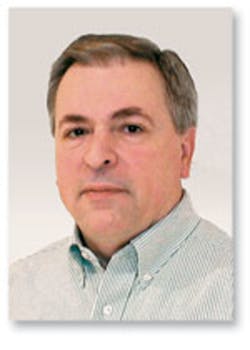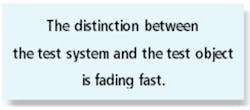We are rapidly approaching a moment of highly disruptive innovation in the test and measurement industry.
The creative forces behind this flow of innovation are many, but for our discussion, they can be reduced to a few fundamental elements:
� Globalization and competitive standardization of goods and information and of entertainment products and services.
� Increased security and performance requirements augmented by global awareness for all major communications, data transmission, and navigation systems.
� Accelerated merging between commercial and military applications through software-defined cognitive platforms.
At a minimum, a viable implementation of the environment for innovation requires interactive, comprehensive, and secure voice, data, and video connection through the Internet with a resulting impetus toward wireless Internet. Then there are the increasingly high levels of integration and development of supporting technologies to allow equipment portability and the lower cost of user and infrastructure equipment to increase the coverage and number of potential users.
These requirements are joined by higher levels of complexity to accommodate broadband communications carrying ever-increasing varieties of applications. Other factors include faster time to market in a truly global and competitive environment and the generation of more Intellectual Property (IP) to protect solutions and investments.
This new environment, one in which the industry often tries to lead potential users, also is characterized by a real-time digitized world where analog and RF/microwave components are only needed to provide highly reliable interface functionality among the users through the transmitting media. Everything else is in a discrete format, with software and digital IP cores rapidly assuming the greatest roles among all components.
It is under these circumstances that the test and measurement industry has been reinventing itself, proactively trying to provide high-value, up-to-date and quickly deployable solutions for an environment that is fast changing and highly competitive in nature.
Overall, what really makes a difference is to have products, applications, and services that effectively transcend current solutions and a consistently recognized market leadership position supported by brand recognition. A compelling selling argument, necessary levels of quality and reliability, and 24/7/365 support round out the requirements.
Achieving the Objectives
What lines of actions can we follow to achieve these objectives? Before we answer this fundamental question, let�s consider some additional observations.
There has never been such an explosion of standards as we are witnessing today, and each standard is becoming more complex. For example, the original standard for the old AMPS analog cellular system was just in the tens of pages while the standards for 3G digital systems are in the thousands of pages. In the headlong rush to secure IPs and provide first preliminary product releases to market, companies sometimes break ranks and bypass universally accepted standardization processes.
The distinction between the test system and the test object is fading fast, making way for INtegrated Test ENSEmbles (INTENSE�) which requires close cooperation between the test object and the test-system designers to generate a fully integrated, efficient, and cost-effective test environment.
And finally, most companies are growing both organically and by acquisition. This implies both localized and distributed products, technologies, and product-development organizations.
Developing the Organization
You could argue that perhaps there is only one principal line of action that needs to be followed: develop the organization. It should be highly tuned both on short- and medium-term market and customer demand as well as long-term technology and emerging market requirements and opportunities. The organization also must be constantly aware of industry innovation as well as competitors� products and future development direction.
This certainly sounds like a winning proposition. However, to give sufficient definition and vitality to this concept, it also is necessary to consider some constraints and characteristics of the associated product-development activities.
Since the complexity of products is constantly increasing, product development is becoming distributed over more than one site. This is especially true for medium and large companies. This process often includes the participation of strategic partners, possible acquisition of new technologies, outsourcing, and strong customer interaction.
Because core competencies usually are localized, particular sites will tend to specialize in specific solutions. To effectively utilize these localized capabilities within the larger ensembles, two major elements must be set in place: Everyone must adopt the same processes and procedures and use the same tools.
To avoid reinventing the wheel for different projects, all solutions should be portable and reusable. This can be best achieved if solutions are modular in nature and platform independent. Then specific modules and IP cores can be used or reused for various projects without changing their basic structure and functionality. Moreover, obsolete components can be replaced with a minimum of rework, reintegration, test, and validation.
Organizational Structure and Human Element
Now that we have discussed the main factors driving change and the various characteristics and constraints of the associated new environment, we need to consider the organizational structure and the human element that actually will allow us to thrive in this new reality.
One approach is to set up a functional engineering organization based on a matrix model. In detail, this translates into an organization composed of systems and technology management, program management, software, hardware, engineering services, new product introduction, test and validation, and product maintenance engineering.
In this structure, the entire engineering organization functions in a mind-share state with all other departments such as marketing, sales, manufacturing, and finance by providing a highly flexible degree of association. This modus operandi also is applied toward associations with partner companies, subcontracting and outsourcing agencies, and customers.
From a formal point of view, the systems and technology management group usually will coordinate activities such as proposal efforts and provide system architects and engineering project leaders for the various projects. Overall, each project benefits from the experience and competencies of the entire organization. Engineering project leaders could be selected from other groups depending on the content and requirements of the project.
Project managers from the program management group work together with the engineering project leaders and are responsible for the overall project and associated deliverables. Individual engineers are assigned from their specialty groups to the various projects as required. Project managers and engineering project leaders work closely with product managers and marketing managers to deliver products and services that address specific customer and market requirements, respectively.
This functional organization is scaleable in nature and can cover several sites or business units. The functional managers are responsible for managing all engineers that are part of each specific function independently of location.
Local engineering operation managers ensure that employees at each location receive training, are properly and periodically assessed, and progress satisfactorily with their professional development.
Besides the excellence, professionalism, motivation, and perseverance of the individual engineers and technicians within such an engineering organization, there are at least two other factors that are paramount in ensuring total success: good management and meaningful metrics.
� Good management must be energetic in nature and characterized by professionalism, respect, company knowledge, business savvy, credibility, charisma, and strong ethical values.
� Metrics are important to ensure that everyone understands what the objectives are, that the financial success for the company is a must, and that there is only one team. We all succeed, or we all fail.
Customers are more and more often requesting complete turnkey solutions. In our fast-moving market, it is unrealistic and often impossible to have either all the necessary knowledge in-house or the time and the financial justification to develop it internally.
Outsourcing is another mechanism that allows specific companies to focus more intensely on their core activities. In a growing scenario, outsourcing frees up valuable local resources that then can be used for core activities. For fixed budgets, outsourcing offers some savings that then can be used to produce more work or improve the company�s bottom line.
Conclusion
We definitely live in exciting times. We have transitioned from rack-and-stack to virtual and now to synthetic INTENSE solutions. The old box-type instrument is disappearing fast, replaced by scaleable, easily upgradeable, platform- and architecture-independent modular solutions.
Product development organizations have gained in flexibility and are assuming a more system-software intensive aspect, supported by aggressive technology and IP core development and management. Strategic partnerships and complementary acquisitions have become the norm that allows us to offer more complete, timely, effective, and cost-efficient solutions to our customers.
We have definitely broken ranks while thinking and acting outside the disappearing box.
About the Author
Francesco Lupinetti, Ph.D., is the CTO for Aeroflex Test Solutions. Dr. Lupinetti�s background includes more than 25 years of pure and applied research, product development, engineering and general management, and business development with companies such as Ericsson, Italtel S.p.A., The MITRE Corp., and Sandia National Laboratories. He received his B.S.E.E., M.S.E.E., and Ph.D.E.E. from Mississippi State University. Aeroflex Test Solutions, 480 Bath Rd., Slough, SL1 6BE, UK, 011 44 (0) 1628 610 358, e-mail: [email protected]
February 2005



